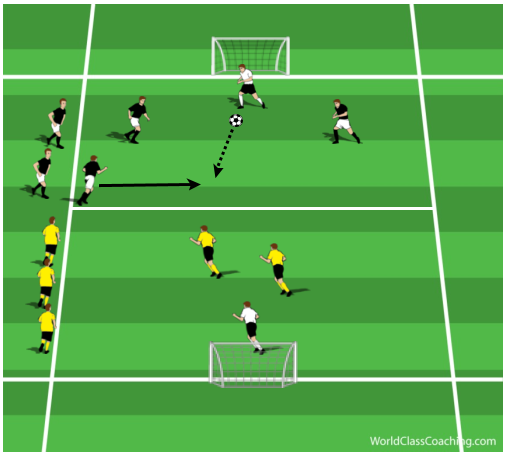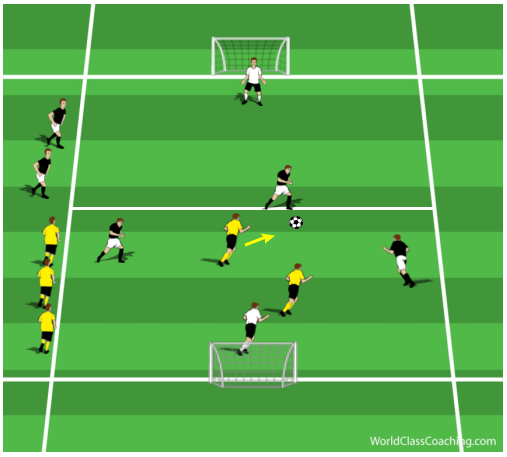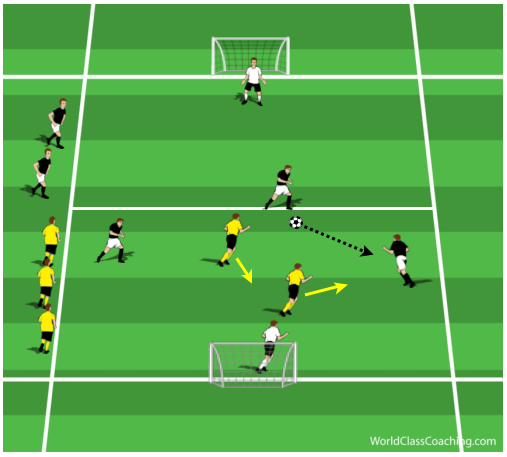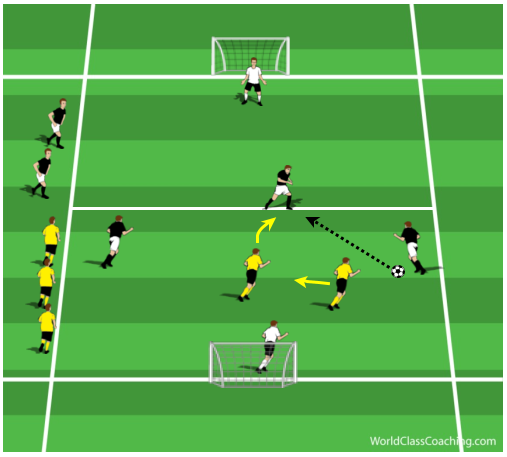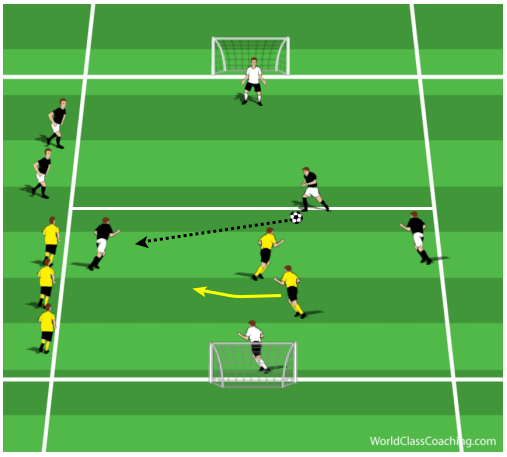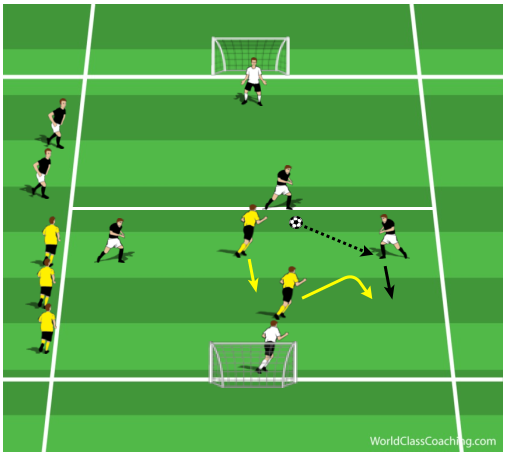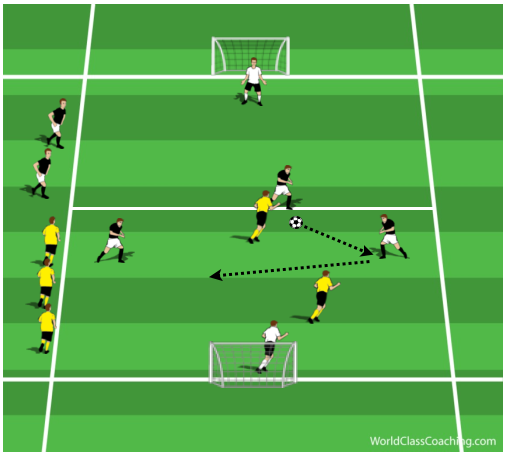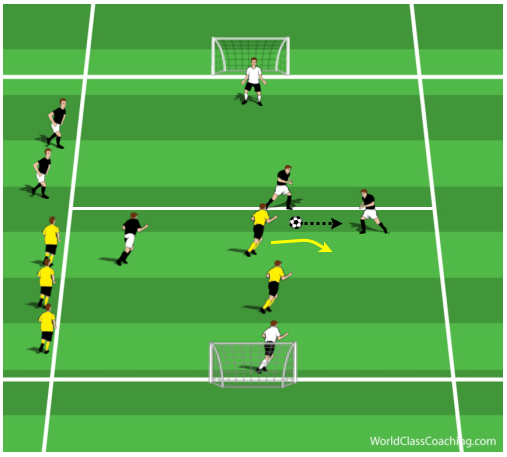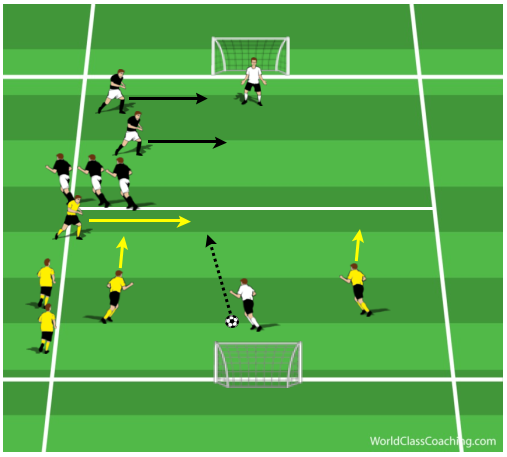This week's post is from Don Herlan, author of Smedley's Drills Volumes 1-4 and Smedley's Defending 20.
This is a drill that I stole from the men’s basketball coach at St. Francis University back when I coached there. He was working with his players on defending the fast break, and I thought that I could use this same drill to work on tandem defense. And it worked great. To me, this is a classic example of what makes for a good drill—there is enthusiasm, there is learning, and there is a total involvement on the part of the players. And like all effective drills, the longer it runs, the better it gets.
‘Numbers down’ drills like this one will get the defenders a ton of repetitions with 3 v 2, 2 v 1, and 1 v 1 situations. And it is essential that they learn how to deal with the dilemma of being a man down until help arrives. Also, they will get to see all kinds of looks and combinations from the attackers—overlaps, takeovers, switches, thru runs—while having to go 1 v 1 with the dribbler at the same time. When this drill is run at top speed, it becomes incredibly game-like and valuable for the defenders.
*Note for the coaches: It takes a little while to get this drill set up and organized, and a few of the players may be a little confused at first about switching in and out of the drill. So give it a couple of minutes. Once the players get into the flow, it's a terrific exercise.
The ball starts with the goalkeeper on every possession, and an attacker releases from the sideline to join the two attackers already in the defending half of the field. The goalkeeper outlets to the attacker coming on (see the diagram at right), and play continues towards the opposing goal, 3 v 2.
The defenders are not allowed to cross the midfield line, and so they must wait in their half as the attackers come in. As the ball comes across, the two defenders assume a tandem posture, with the 1st defender going to the ball and the 2nd defender dropping back to a covering position. The defending pair must play in this position-one up and one back-at all times. If they play square to one another, then the ball can be played down the center of the field, and that is something that they have to stop right away.
Typically, the attack will start this way, with the ball in the center of the field and the attacker dribbling at the 1st defender. As the attacker approaches goal, the first defender moves up to stop the ball. First and foremost, the 1st defender cannot get beat 1 v 1. The defense is already in a man-down situation, and they certainly can’t afford to turn this play into a 3 v 1 disadvantage. So the 1st defender must play under control and not charge in. Instead, he should delay the attack and not be overly aggressive. And as he does, he should push the play in one direction by curving his run to the ball. In the diagram at left, the 1st defender has approached the ball from the left, forcing the play to the right side. And more importantly, he has forced the attacker onto his left foot, which is probably his weaker side. If the approaching run is made correctly, then the attacker on the left will be taken out of the play. The 2nd defender can read the approaching run and shade towards the right side of the field, rather than stand directly behind the 1st defender. This will give him a head start when it’s time for him to go to the ball.
When the first pass is made, the 2nd defender makes his approaching run out to the ball, leaving his covering position. Every time the ball is passed, the defenders and the goalkeeper talk to each other, confirming who is going to the ball and who is dropping back to cover. And when the defender drops back to cover, he drops straight back. He doesn’t take any steps towards the ball. He simply turns and runs back towards the goal. This is crucial in defending, because a failure to drop straight back will leave the defense susceptible to the thru ball. And that is the worst case scenario in this drill (more on this later on).
After the defenders make the correct runs and the ball is stopped, the attackers will have two choices: Take the defender on 1 v 1 on the flank or pass the ball back out. And the smart play is to pass the ball back out. When the ball is passed, the defenders switch again, closing down on the ball with the 1st defender and covering with the 2nd. This piston type movement will be made hundreds of times during this drill, and hopefully, it will become second nature to the defenders in a short period of time. But the movement is always the same: one defender goes to the ball, the other covers. And the covering player should always be in a position to where he can get to the next pass, regardless of the direction. The cover player has to be able to close down on passes made to the left and the right.
In the example above, the ball continues to travel from right to leftt, and the covering defender has to be close enough to get out to the ball before the attacker can shoot. That is a theme for the attackers in this drill—to move the ball faster than the defenders can recover. But in this case, the covering defender has read the play, and he gets out to the ball in time. Whenever the two defenders can force the attackers to pass the ball back and forth around the outside, this is in essence a victory for the defense. Because if this were an actual game, a third defender would be tracking back to join the play. In man-down situations such as this, the defense should always look to contain the play until help arrives as opposed to trying to win the ball.
But the defenders can improve their chances of winning the ball during this drill a little bit. By curving their approaching runs and forcing the play in one direction, they can turn the 3 v 2 situation into a 2 v 2 or a 1 v 1. And they can use the sideline to their advantage as well.
In the diagram at right, the 1st defender has forced the play to the right and to the outside. As the defenders switch, the 2nd defender curves his run, showing the attacker a little space to dribble into. But when he takes it, the defender closes him down, creating a 1 v 1 near the sideline. And this is a best case scenario for the defense - a 1 v 1 in a small space, one that will be difficult for the attackers to pass out of. The defender can be fairly aggressive in this 1 v 1, and so his chances of coming up with the ball will be good.
Now that’s the best case scenario. But what can go wrong in this drill? How can the attackers make life hard for the defenders? Well, I mentioned one way already—the thru pass. This one is the killer, and it’s tough to stop when the attackers do it correctly. Especially if the defense is a little slow.
When a pass goes to the outside, the defender on top has to drop straight back. If he stays out on top or wanders towards the pass—even a half a step—the ball can be played thru to the third attacker. And that attacker will be free to go to goal, since the defenders have moved over to the other side to cover the previous pass.
The straight drop is crucial for the defenders. That first defender has to be conservative and ready to head back towards goal each time a pass is made. If he’s too aggressive and pressing forward, the ball will get played in behind him. And it’s up to the goalkeeper and the 2nd defender to get that 1st defender to come back. The defense will live and die together as a group, and so everybody has to be on the same page. You’re not going for big steal and huge tackles in this drill. You're stalling and containing the play. So the defender's job is to pressure and cover, pressure, and cover.
[wpsharely id="6889"][/wpsharely]One other way that the defenders can get their signals crossed is on short passes, situations where it becomes unclear which defender should go to the ball, such as the one on the left. Since it’s a short square pass, the covering defender will have to make a long run out of the back to cover the ball. The defender on top is actually closer. And so he should be the one to pressure that pass. He should simply chase the ball since it’s a short run. But—he should call it out as he goes. He should yell “I got ball!” so that both defenders don't end up going to it. Miscommunication is a common foul up in this drill, especially when the attackers move the ball quickly and play with some imagination. If the attackers play slowly and just come down the field in straight lines, life will be fairly easy. But if they play one and two touch soccer, pass the ball thru, and throw 2 v 1 combinations at the defenders, then life will be difficult. There will be a lot more running and lots of split-second decision making. You'll see what I mean when you run this drill. When the attackers run it at speed and push the dribble aggressively, it makes for a pretty interesting day for the defense.
And finally—when the defenders do win the ball in this drill, they play it back to their own goalkeeper and stay on the field for the next attack. A teammate comes on, and now they have their own 3 v 2.
During the drill, players shuttle on and off the field continuously throughout this drill, and all of the players will get plenty of chances to play on both sides of the ball. Keep the drill moving and let the players learn from the drill itself. When you get a great example of what to do (or not do) during play, stop the drill, make your point, and then let the drill run again. By the time you're done with this exercise, you'll see marked improvement in how well your defense can handle this man-down situation.
Try this with your team and let us know how it goes.
Have a Great Day!
Tom Mura

